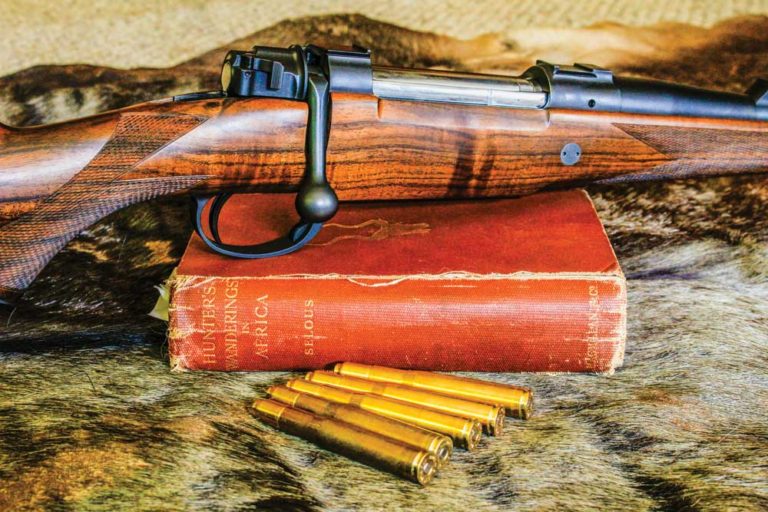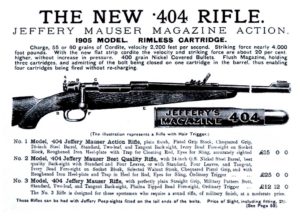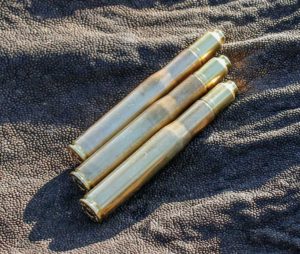One Gun to Hunt Them All: The Historic .404 Jeffery
Posted: Thu Dec 01, 2016 4:16 pm
From the Gun Digest http://www.gundigest.com/article/one-gu ... 04-jeffery
One Gun to Hunt Them All: The Historic .404 Jeffery
By: Philip Massaro | August 2, 2016
The actual year that the .404 Jeffery was released is a source of debate and even argument among those who study cartridge history, and particularly African hunting cartridges. Most research will indicate that 1909 was the official release date, yet Phil Shoemaker — the famous brown bear guide from Alaska — has a rifle that dates back to 1907, clearly original and clearly chambered for the .404 Jeffery.
It doesn’t really matter; let’s agree that the latter portion of the first decade of the 20th century saw the .404 burst onto the scene. Its purpose was to replicate the ballistics of the steadfast .450/400 3-inch Nitro Express in a bolt-action rifle, and it worked. The bullet diameter was changed from .410” to .411” for the .450/400 to .423” for the .404 Jeffery — for reasons I can’t quite figure out — and the new case drove a 400-grain bullet at a muzzle velocity of 2,125 fps for 4,020 ft-lbs of energy, as well as a 300-grain copper pointed bullet at 2,625 fps, designed for long-range work. The .404 has an 8-degree shoulder; usually a cartridge that doesn’t feature a rim or a belt features a much more prominent shoulder in order to facilitate good headspacing. That said, I’ve never had a single problem with headspacing in the .404 Jeffery, and that slight shoulder allows the cartridge to feed like a dream — and that’s an important feature on any dangerous-game cartridge. While it became very popular among British rifle makers, it was also embraced by German rifle makers, designated as the 10.75x73mm.
That early muzzle velocity of 2,125 fps may seem sedate when compared to the .375 H&H Magnum or the .416 Rigby, which run at 2,550 fps with a 300-grain bullet and 2,410 fps with a 400-grain bullet, respectively. But it is enough to ensure reliable expansion and penetration with the standard cup-and-core softpoints and steel jacketed solids. All this in a cartridge that has, possibly, the mildest perceived recoil of any of the dangerous-game cartridges I’ve used. The combination of mild recoil and the ability to place those bullets where they need to be is tantamount to quickly dispatching game animals. It was so effective, in fact, that the game departments of both North and South Rhodesia (now Zambia and Zimbabwe), Tanzania and Kenya chose the Vickers bolt-action rifle chambered in .404 Jeffery as the standard-issue rifle. In my opinion, if it was good enough for those guys required to handle the problem animals, it is good enough for me. The .404 Jeffery has the distinction of taking what many consider to be the greatest North American trophy ever taken — the Chadwick ram — the world record stone sheep taken in British Columbia in 1936 by Dr. Chadwick.
The original .404 load quietly made a fantastic reputation among those who had the opportunity to use it on a daily basis — folks like John “Pondoro” Taylor, who in his classic book, African Rifles and Cartridges, would testify to the effectiveness of the Jeffery cartridge. But, that original load didn’t stick around for long. Kynoch bumped the muzzle velocity from 2,125 fps to 2,225 fps, also increasing the muzzle energy by almost 400 ft-lbs, recognizing the fact that the .404 Jeffery case was capable of more than what was being loaded. More about that in a minute…
The early part of the 20th century saw many great safari cartridges introduced; some would fade into obscurity and some would go on to become undeniable classics that few hunters would not insist on having in their collection. The .375 Holland & Holland Magnum certainly heads that list; it is perhaps the single most useful cartridge ever invented, and while it may not be perfect for everything, it will certainly get the job done on any game animal, anywhere. The writings of Robert Ruark brought the proprietary .416 Rigby into the spotlight, and I’d confidently say that without that book, the Rigby cartridge and the .416-inch bore diameter would’ve walked off into the sunset. The prestigious firm of Westley Richards answered the .404 Jeffery by releasing the .425 Westley Richards, using a .435” diameter bullet at 2,350 fps for just over 5,000 ft-lbs of energy. However, the severely rebated rim of the .425 didn’t give reliable extraction, so it didn’t gain a huge following, and is a rarity today.
The .450-400 3” NE was, and still is, a wonderful choice for a hunter, but the rimmed cartridge is usually reserved for the double rifles and single-shots; the former became very expensive to produce and the latter fell out of vogue until the advent of the Ruger No. 1 in the 1960s. By the middle of the 20th century, much of Africa had begun the plunge into political turmoil, and ammunition for many of the big double rifle calibers like the .450 NE and .470 NE became increasingly harder to find.
To fill the void, the .458 Winchester Magnum came on the scene in the 1950s in the affordable and reliable Winchester Model 70 bolt-action rifle, reproducing (at least in theory) the ballistics of the venerable .450 Nitro Express. For many years, a sportsman didn’t have much choice for a safari; you either grabbed a .375 or a .458. Still, there were those few who quietly hoarded .404 rifles and ammunition, using the vintage rifles with great effect on all shapes and sizes of game.


